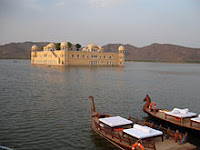 India is the largest producer of films in the world. Indian film industry is multi-lingual and the largest in the world in terms of ticket sales and number of films produced. The industry is supported mainly by a vast film-going Indian public, and Indian films have been gaining increasing popularity in the rest of the world—notably in countries with large numbers of expatriate Indians.
India is the largest producer of films in the world. Indian film industry is multi-lingual and the largest in the world in terms of ticket sales and number of films produced. The industry is supported mainly by a vast film-going Indian public, and Indian films have been gaining increasing popularity in the rest of the world—notably in countries with large numbers of expatriate Indians.
Largest film industry in India is the Hindi film industry mostly concentrated in Mumbai(Bombay), and is commonly referred to as "Bollywood", an amalgamation of Bombay and Hollywood. The other largest film industries are Telugu cinema and Tamil cinema which are located in Hyderabad and Chennai are commonly referred to as "Tollywood" and "Kollywood" . The remaining majority portion is spread across northern, western, and southern India (with Punjabi, Bengali,Marathi, Oriya, Malayalam, Kannada). However, there are several smaller centers of Indian film industries in regional languages centered in the states those languages are spoken. Indian films are made filled with musicals, action, romance, comedy, and an increasing number of special effects.
History of Indian Cinema :
Motion pictures came to India in 1896, when the Lumière Brothers' Chinematographe unveiled six soundless short films in Bombay (now Mumbai). This was just one year after the Lumière brothers (inventors of cinematography) had set up their company in Paris.
The first Indian on record to make a movie was Harishchandra Sakharam Bhatvadekar (nickname: Save Dada). He made one short film on a wrestling match at the Hanging Gardens in Bombay, and another on the playfulness of monkeys. Both these shorts were made in 1897 and were publicly exhibited for the first time in 1899 using Edison's projecting kinetoscope inside a tent which the film maker had himself erected.
India's first feature film – named "King Harishchandra" – was released in 1913. It was made by Dhundiraj Govind Phalke (nickname: Dadasaheb Phalke, 1817-1944). This was a silent movie. The rapid growth of Indian cinema led to the end of Silent era and ushered in the era of the talkies. The latter introduced the Indian cinema in a completely new way to the audiences. Now one could hear the actors & actress talk, laugh, sing and cry. The first talkie made in India was "Alam Ara" (produced by Imperial Film Company) released in 1931.
1930s & 1940s witnessed the rise of film personalities, such as Debika Bose, Chetan Anand, S. S. Vasan, Nitin Bose and others. By this time apart from Bombay(Mumbai), the Indian film industry shaped up well in down south too. The Tamil, Telugu, Kannada film industries were making indigenous films as well.

The golden period in history if Indian cinema is attributed to the 1950s. Guru Dutt, Mehaboob Khan, Raj Kapoor, Balraj Sahani, Nargis, Bimal Roy, Meena Kumari, Dilip Kumar, Madhubala graced the screens. Besides them numerous singers, composers, scriptwriters, cameraman and other technician lend a helping hand in making some of the most outstanding films that carved their own niche in the history of Indian Cinema.
In 1960s Indian cinema moved one step further with the release of K. Asif's Mughal-e-Azam. A trail of romantic movies followed all over India.
By 1970s Indian cinema enjoyed the histrionics of superstars like Rajesh Khanna, Sanjeev Kumar, Waheeda Rehman, Asha Parekh and others. This was truly the red letter year for Hindi cinema as Ramesh Sippy's Sholay proved to be an iconoclast and gave to Indian cinema its new superstar - Amitabh Bachchan.

1980s saw the rise of several women directors, such as Aparna Sen, Prema Karnath, Meera Nair & other. It was also the year when Rekha wooed the audience with her stunning performance in Umrao Jaan. The regional films like Malayalam, Kannada, Telugu, Bengali & others produced a number of romantic films.

1980s saw the rise of several women directors, such as Aparna Sen, Prema Karnath, Meera Nair & other. It was also the year when Rekha wooed the audience with her stunning performance in Umrao Jaan. The regional films like Malayalam, Kannada, Telugu, Bengali & others produced a number of romantic films.
With romantic films at the helm the Indian cinema ushered into 1990s. A mixed genre was witnessed during this time. Romantic, thriller, action and comic movies were made. Gradually the face of Indian cinema was undergoing changes one again. The contemporary Indian cinema, keeping pace with time & technology, witnessed dolby digital sound effects, advanced special effects, choreography, international appeal, further investment from corporate sectors along with script & performances.
Now a days, the technology of film-making in India is perhaps the best among all developing countries. Stars like Sharukh Khan, Aamir Khan, Hritik Roshan, Abhishek Bachchan, Priyanka Chopra & Others explored all possible techniques to enrich Indian cinema with their performances.
Now a days, the technology of film-making in India is perhaps the best among all developing countries. Stars like Sharukh Khan, Aamir Khan, Hritik Roshan, Abhishek Bachchan, Priyanka Chopra & Others explored all possible techniques to enrich Indian cinema with their performances.
I don’t claim the information to be my own. The information is compiled from different sources






































.jpg)





